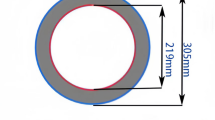Abstract
This paper aims to present an experimental investigation on the behaviour of interfaces between pumice LWAC (lightweight aggregate concrete) and HPC (high-performance concrete-high-strength and fibre-reinforced), typically found in the faces and core, respectively, of hybrid precast structural sandwich panels. The evaluation of the experimental data resulted in the derivation of a semi-empirical relationship that relates the interface strength with materials strength, interface geometry and loading parameters. A brief overview of existing shear friction theories and proposed relationships, as well as a somparison among existing models and that proposed by the authors, are also outlined in the paper.
Résumé
Cet article décrit une recherche expérimentale sur le comportement des interfaces face-noyau qui existent au niveau des panneaux sandwich structurels, hybrides et préfabriqués, composés de faces en béton de haute pression (renforcé par des fibres) et un noyau en béton aux agrégats légers (de la pierre ponce). L'évaluation des données expérimentales a abouti à la dérivation d'une relation semiempirique qui établit un rapport entre la puissance des matériaux, la géométrie de l'interface et les paramètres de la charge. Une brève description des théories existantes du cisaillement-frottement et des relations proposées, ainsi qu'une comparaison parmi les modèles existants, dont celui proposé par les auteurs, sont aussi présentées.
Similar content being viewed by others

References
Birkeland, P. and Birkeland, H., ‘Connections in precast concrete construction’,ACI Journal Proceedings 63 (3) (1966) 345–368.
Mattock, H. A. and Hawkins, M. N., ‘Shear transfer in reinforced concrete—Recent research’,PCI Journal 17 (2) (1972) 55–75.
Tassios, T. P. and Vintzêleou, E. N., ‘Concrete-to-concrete friction’,ASCE Journal of Structural Engineering 113 (4) (1987) 832–849.
Walraven, J., Frénay, J. and Pruijssers, A., ‘Influence of concrete strength and load history on the shear friction capacity of concrete members’,PCI Journal 32 (1) (1987) 66–84.
Bass, R. A., Carrasquillo, R. L. and Jirsa, J. O., ‘Shear transfer acros new and existing concrete interfaces’,ACI Structural Journal 86 (4) (1989) 383–393.
Ali, M. A. and White, R. N., ‘Enhanced contact model for shear friction of normal and high-strength concrete’,ACI Structural Journal 86 (4) (1989) 348–360.
Walraven, J. C. and Al-Zubi, N., ‘Shear capacity of lightweight concrete beams with shear reinforcement’, in ‘Proceedings of the International Symposium on Structural Lightweight Aggregate Concrete’, Sandefjord, Norway, 20–24 June 1995, (Norwegian Concrete Association, 2000) 91–104.
Mattock, H. A., ‘Effect of aggregate type on single direction shear transfer strength in monolithic concrete’, Report SM 74-2, (Department of Civil Engineering, University of Washington, August 1974).
CSA, ‘Design of Concrete Structures for Buildings’, (CAN3-A23.3-A94, Concrete Standards Association, Rexdale, Ontario, 1994).
ACI Committee 318, ‘Building Code Requirements for Reinforced Concrete (ACI 318-95) and Commentary (318R-95)’, (American Concrete Institute, Parmington Hills, Mich., 1995).
Mattock, H. A., ‘Discussion’,PCI Journal 33 (1) (1988) 165–166.
Mau, S. and Hsu, T., ‘Discussion’,PCI Journal 33 (1) (1988) 166–170.
Loov, R. E. and Patnaik, A. K., ‘Horizontal shear strength of composite concrete beams with a rough interface’,PCI Journal 39 (1) (1994) 48–109.
fib Task Group 8.1, ‘Lightweight Aggregate Concrete—Codes and Standards’, (The International Federation for Structural Concrete (fib), Sprint-Druck, August 1999).
Mattock, A. H., Li, W. K. and Wang, T. C., ‘Shear transfer in lightweight reinforced concrete’,PCI Journal (January–February 1976) 21–39.
Walraven, J. C., Vos, E. and Reinhardt, H. W., ‘Experiments on shear transfer in cracks in concrete—Part I—Description of results’ (5-79-3 TUDelft 1979).
Hamadi, Y. D. and Regan, P. E., ‘Behaviour of normal and lightweight aggregate beams with shear cracks’,The Structural Engineer 58B (4) (1980) 71–79.
Balaguru, P. and Dipsia, M. G., ‘Properties of fiber reinforced high-strength semilightweight concrete’,ACI Materials Journal 90 (5) (1993) 399–405.
Thorenfeldt, E., ‘Design criteria of lightweight aggregate concrete’, in ‘Proceedings of CEB/FIP International Symposium on Structural Lightweight Aggregate Concrete’, Sandefjord, Norway, (Editors: I. Holand, T. A. Hammer and F. Fluge, June 1995).
Papanicolaou, C. G. and Triantafillou, T. C., ‘Mechanical behavior and optimum design of concrete panels made of High Strength Concrete (HSC) faces and Lightweight Aggregate Concrete (LWAC) core’, in ‘Structural Concrete—Bridge Between People’ Proceedings of the FIB Symposium, Prague, 12–15 October 1999, V. 2, Viacon Agency, Prague, 1999) 411–416.
Shyh-Jiann Hwang, Hsin-Wan Yu and Hung-Jen Lee, ‘Theory of interface shear capacity of reinforced concrete’,Journal of Structural Engineering 126 (6) (2000) 700–707.
Walraven, J. C., ‘Size effects: their nature and their recognition in building codes’, in ‘Proceedings of JCI International Workshop on size Effect in Concrete Structures’, Sendai, Japan, 31 October—2 November 1993, 295–314.
Niwa, J., Kawaguchi, T., maehori, S. and Okamoto, T., ‘Shear capacity of normal strength super lightweight concrete beams’, in ‘Proceedings of the Second International Symposium on Structural Lightweight Aggregate Concrete’, Kristiansand, Norway, 18–22 June 2000, (Norwegian Concrete Association, 2000) 299–308.
Den Uijl, J. A., Stroband, J. and Walraven, J. C., ‘Splitting behaviour of lightweight concrete’, in ‘Proceedings of the International Symposium on Structural Lightweight Aggregate Concrete’, Sandefjord, Norway, 20–24, June 1995, (Norwegian Concrete Association, 2000) 154–163.
Reinhardt, H. W., ‘Length influence on bond shear strength of joints in composite precast concrete slabs’,International Journal of Cement Composites and Lightweight Concrete 4 (3) (1982) 139–143.
Author information
Authors and Affiliations
Additional information
Editorial Note Prof. Thanasis C. Triantafillou is a RILEM Senior Member.
Rights and permissions
About this article
Cite this article
Papanicolaou, C.G., Triantafillou, T.C. Shear transfer capacity along pumice aggregate concrete and high-performance concrete interfaces. Mat. Struct. 35, 237–245 (2002). https://doi.org/10.1007/BF02533085
Received:
Accepted:
Issue Date:
DOI: https://doi.org/10.1007/BF02533085



